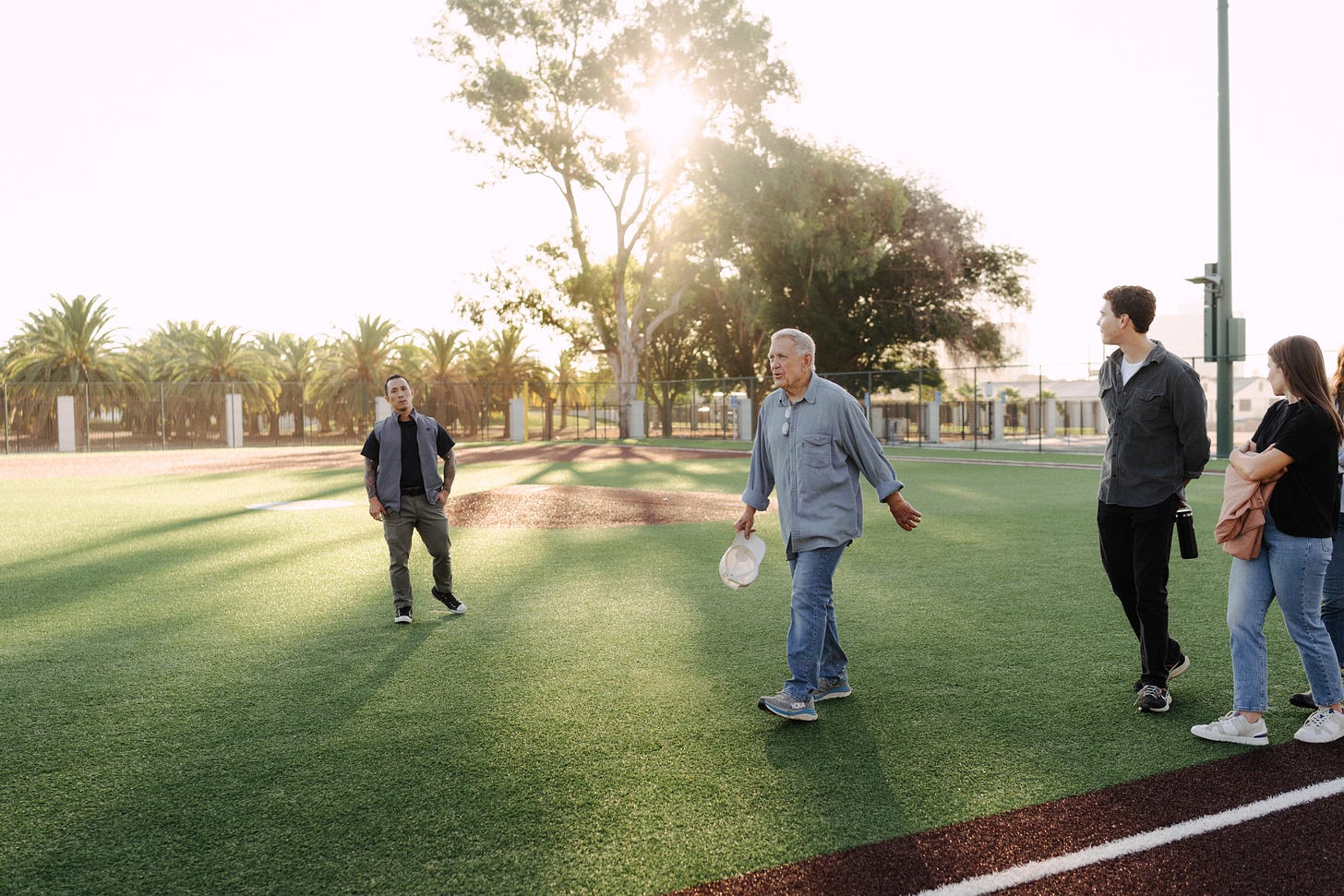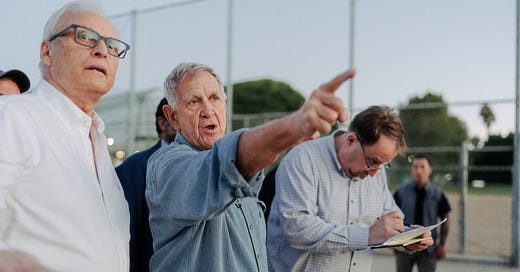Day 9: Judge Carter tours the West Los Angeles VA property
During an hours-long walk through the campus, the judge, wearing a Marine Corp cap, eyed spots where they could build veteran housing. “I never would have gotten this from a map," he said.
Editor’s note: Day 8’s briefing was edited, post-publication. To read a current version of last Friday’s newsletter, please click here.

Before the sky even hinted at dawn on the ninth day of proceedings in Powers v. McDonough, Judge David O. Carter walked briskly around the athletic facilities of the Brentwood School, which have been a major point of contention in the trial.
The facilities, including the school’s pool, football and baseball fields, and tennis courts were the first stops on a walking tour of the West Los Angeles Veterans Affairs campus that started before 5 a.m. on Wednesday and did not end until late morning.
Carter, dressed in jeans, running shoes, a loose button-down shirt, and a United States Marine Corps baseball cap, stalked across the pool deck surrounded and followed by more than a dozen people, including plaintiffs’ counsel Roman Silberfeld and Department of Justice attorney Brad Rosenberg, veterans advocate Rob Reynolds, the judge’s clerks, and several reporters.
As Carter left the pool facility, walking past the ivy-covered walls of the school, he headed to the nearby softball and baseball fields. The outfields of the two parks adjoin each other, creating a wide open expanse of lush grass. He walked from one end of the field to the other, at times pausing to look out at the expanse. Occasionally, he would make a quick turn one way and a quick turn another as the entourage sometimes struggled to keep up. At times he would take off his cap and use it to gesture at an area or facility before jamming it back on his head and walking.
At the fields, Carter could be heard conversing with Silberfeld and Rosenberg asking them to overlay the layouts of buildings 205, 208, and 209, recently renovated housing units, onto the fields.
“What does that look like here?” he asked.
Long Lead is reporting from Powers v. McDonough every day court is in session. Subscribe here to get our daily briefings sent direct to your inbox every morning:
Walking off of the Brentwood School property, Carter led the cadre to Veterans’ Barrington Park, athletic fields and a dog park on VA land leased by the City of Los Angeles.
The fields were pockmarked with gopher holes and appeared much less maintained than the Brentwood School’s green spaces.
Carter examined the field before continuing on his tour of the campus, walking the hilly terrain to the east side of the campus where the Bridgeland oil well sits, adjacent to the 405 Freeway.
The week prior, the judge had previously expressed concern over a potential settlement between Bridgeland and the plaintiffs that would see over an acre of site given over to the VA for housing (or potentially a parking lot).
On Wednesday, Carter stood with his back to the freeway and marked off approximately 500 feet. I’m not building next to a freeway, he said.

The next stop was the UCLA baseball complex which includes Jackie Robinson Stadium and the Branca Family practice field, also on VA land. Carter surveyed the area from the top of the grandstands and moved down to an adjacent parking lot and to nearby gardens which were overgrown. Abutting the area leading to the gardens is a neighborhood of large single-family homes separated from the VA campus by a fence. Carter asked Silberman to demarcate a “setback” a few hundred yards from the fence separating the area and the homes as if he were surveying for a potential building.
Despite the rising temperatures as the sun rose in the sky, Carter continued on his tour walking next to some of the campus’ residential buildings. He waved in some of the journalists to view the buildings and an empty unit. “You’re the taxpayers, it’s yours,” he said.
The tour continued on as the judge walked from one point of interest to another, from the dilapidated Wadsworth Chapel, where Carter and members of the group were required to don hard hats, masks, and bright yellow vests, to CTRS, a group of ‘tiny homes’ installed on the campus near where Veterans Row once lined San Vicente Boulevard.
Carter did not want to see only landmarks and buildings and tended fields — on one occasion he led the group through an undeveloped parcel of land shaded by trees with a heavy layer of foliage on the ground.
As the tour came to a close, after several miles and over five hours, he thanked Silberfeld, Rosenberg, Reynolds, and the VA staff for inviting him to tour the campus.
“I never would have gotten this from a map,” he said.
Carving up the map
After prohibiting veterans from living permanently on land donated to house them, the VA entangled itself in a wild array of leases on the valuable Los Angeles property — from soccer pitches to parrot sanctuaries — inhibiting the government from solving a homeless crisis of its own creation.
If the VA isn’t housing veterans on this land, what is the property being used for? Learn more by reading Part Four of Home of the Brave.
Back in the courtroom, the plaintiffs called Steve Soboroff, who has, among other duties, served as the LAPD commissioner and the president of the LA Recreations and Parks Commission. He has also played a role in several major Los Angeles developments including the Staples Center (now called the Crypto.com Arena) and, notably, the neighborhood of Playa Vista which saw the development and construction of thousands of housing units.
Soboroff testified about the need for housing on the VA campus calling the homelessness crisis “an American tragedy” and denigrating the “tiny shelters” as looking like toilets. “Except they don’t have toilets,” he said.
Soboroff expounded on a report he had prepared for the plaintiffs to place up to 1,000 units of temporary housing on the campus. He had identified six parcels where the housing could go, how much could be placed on each parcel, and the types of homes that could be built. Regarding one slide which showed an example of temporary homes Soboroff offered: “Give us 18 months from tomorrow… and that will be there.”
The defense challenged Soboroff on his rosy timeline, presenting him with testimony he had given in a deposition showing that he did not know about the National Environmental Policy Act which requires federal agencies to undertake impact assessments prior to making decisions.
More from Long Lead — “Long Shadow: 9/11’s Lingering Questions”
While thorough, large-scale efforts like the 9/11 Commission tried to make sense of that chaotic day, many questions remain. Hosted by Pulitzer-finalist historian Garrett Graff, “Long Shadow: 9/11’s Lingering Questions” attempts to answer those questions and explore other enduring mysteries surrounding 9/11. A number one-ranked history podcast on Apple Podcasts, “Long Shadow” was named the best history podcast by the Signal Awards. Listen and subscribe wherever you get your podcasts.
But much of Soboroff’s questioning came from Carter who drilled down the proposed sites for temporary housing and some of the issues they presented. On multiple parcels, Carter asked about the potential issues that would arise from residents and homeowners. They’d be NIMBYs, Soboroff said.
On another parcel where there currently is a lot open to veterans to sleep in their cars overnight, Carter asked why it should be removed to make way for housing. Low utilization, Soborhoff offered.
Carter pressed, asking how many cars use the lot per night. “I have a feeling no one really knows,” Carter said.
What also drew Carter’s attention were not the parcels Soboroff had selected for housing but the ones he had not, namely the Brentwood School, UCLA’s baseball field, and Veterans’ Barrington Park, which he noted “the city supposedly maintains it but if you walk it, it’s as poorly maintained as possible.”
Soboroff countered that removing a city park would create a firestorm of political blowback. “I think there’s more of a firestorm from homeowners and renters,” Carter replied.
Proceedings for Powers v. McDonough will continue on Thursday, August 22 at 8:00 a.m.








